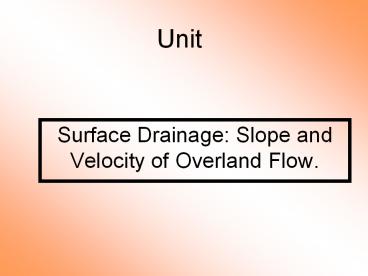Surface Drainage: Slope and Velocity of Overland Flow. - PowerPoint PPT Presentation
Title:
Surface Drainage: Slope and Velocity of Overland Flow.
Description:
Unit Surface Drainage: Slope and Velocity of Overland Flow. Unit Surface Drainage: Slope and Velocity of Overland Flow. 2. Describe the impact of roughness (friction ... – PowerPoint PPT presentation
Number of Views:581
Avg rating:3.0/5.0
Title: Surface Drainage: Slope and Velocity of Overland Flow.
1
Unit
- Surface Drainage Slope and Velocity of Overland
Flow.
2
Objectives
1. Quantify the relationship between slope and
velocity.
2. Describe the impact of roughness (friction) on
velocity.
3. Make design decisions relative to slope and
roughness to control water velocities in surface
drains.
3
Terms
Non-linear relationship Runoff Slope Velocity
4
How does slope affect velocity?
- Velocity, distance divided by time, increases
at a ratio of v to the square root of the slope.
5
Velocity
- Slope is the amount of rise divided by the
amount of run or distance traveled.
6
Mannings Equation
-can help estimate the velocity of a fluid in a
channel with many variables.
7
What affect does friction have on velocity?
8
Friction affects.
- Friction affects the velocity of water in a
channel.
- The roughness coefficient determines the speed
of the water.
9
- Winding, sluggish and weedy banks slow water
down more than smooth straight channels.
10
Runoff
-is water and soil that travel along the soil
surface.
- The runoff of a land area is dependent on the
infiltration and percolation rates of the soil as
well as the precipitation levels.
11
Runoff
- The precipitation levels cannot be controlled.
The soil characteristics will change over time,
and as erosion increases the soil characteristics
will differ.
12
How can changing slope and friction control water
velocity in surface drains?
13
- The roughness, slope, and velocity of a channel
all impact erosion and surface drainage.
14
-As the roughness of a channel increases the
velocity of the water decreases. This forms an
indirect relationship.
15
-Roughness is difficult to change in an existing
waterway but can be affected in a newly created
waterway situation.
16
-The velocity of water flowing overland in an
open channel varies as the square root of the
slope in ft/ft. The relationship is nonlinear.
17
-Slope is topographical and cannot easily be
changed in a large channel but may be altered in
smaller channels.
18
MANNINGS EQUATION
19
Roughness Coefficient n, for the Manning Formula
Lined channels
Type and Description of Channel
n Value
Asphalt
0.015
Concrete
0.0120.013
Concrete rubble
0.0170.030
Smooth metal
0.0110.015
Corrugated metal 0.0210.026
Plastic
0.0120.011
Wood
0.0110.015
20
Vegetated Channels
Dense, uniform stands of green vegetation more
than 10 in. long
Bermuda grass 0.040.20
Kudzu 0.070.23
Common Lespedeza 0.0470.095
Dense, uniform stands of green vegetation cut to
a length of less than 2.5 in.
Short Bermuda grass 0.0340.11
Kudzu
0.0450.16
21
Earth Channel and Natural Streams
Clean, straight bank, full stage
0.0250.040
Winding, some pools and shoals, clean
0.0350.055
Winding, some weeds and stones
0.0330.045
Sluggish river reaches, weedy or with very deep
pools
0.0500.150
22
Earth Channel and Natural Streams
Clean, straight bank, full stage
0.0250.040
Winding, some weeds and stones
0.0330.045
Winding, some pools and shoals, clean
0.0350.055
Sluggish river reaches, weedy or with very deep
pools
0.0500.150
23
Pipe
0.009
Asbestos cement
Cast iron
0.011 0.015
Clay or concrete (412 in.) 0.010 0.020
Corrugated metal 0.021
0.0255
Corrugated plastic (24 in.) 0.016
Riveted and spiral steel 0.0130.017
Vitrified sewer pipe
0.0100.017
Wrought iron
0.0120.017































